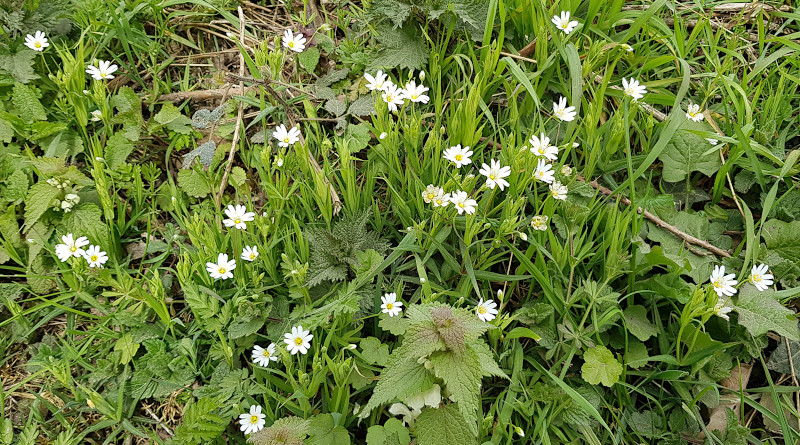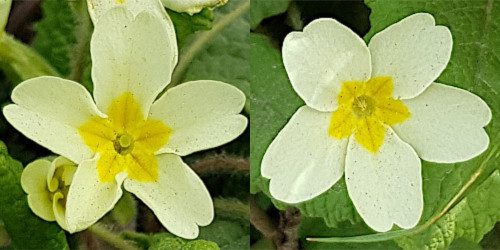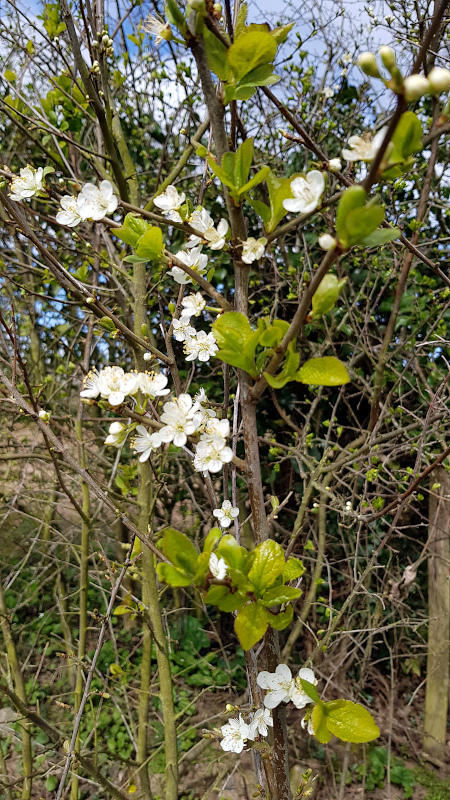Even with the current coronavirus restrictions, we can – for the time being – take a regulation walk along the lanes close to the village for exercise. At this time of year, the road verges start to show an abundance of wild flowers.
Headache

One of my favourite hedgerow flowers is the Greater Stitchwort (Stellaria holostea) which grows in profusion along the lanes at this time of year. It has star-shaped flowers with yellow pollen-bearing anthers. It goes by a host of alternative names including wedding cakes, brassy buttons, daddy’s shirt buttons, headache, adder’s meat, star of Bethlehem, milkmaids and snapdragon. When the seed capsules eventually mature they can pop loudly.
The plant reputedly has herbal properties getting its most common name from its use to cure runners’ side stitch – and presumably headaches as well. Many plants naturally contain a chemical called salicylic acid (originally isolated from the willow – Salix). Salicylic acid is used by the plant as part of a defence process against pathogens – including plant viruses. The pharmaceutical industry manufactures the painkiller Aspirin from salicylic acid.
Pin and thrum
Wild primroses (Primula vulgaris) seem to be much more abundant in the verges than they used to be. And what a cheery sight they are in these days of lockdown. Closer inspection of these gorgeous yellow blooms shows that primrose flowers come in two types, called pin and thrum. In the centre of pin flowers, the top of the female reproductive organ – the stigma which receives the male pollen – can be seen. In these plants, the male pollen-bearing anthers are further down inside the flower. By contrast, thrum flowers have male anthers near the top and the female stigma further down.

Charles Darwin was first to study pin and thrum primroses. He suggested that the different positions of anthers and stigma was a mechanism to prevent self-pollination. Cross-pollination increases genetic variability producing more adaptable offspring.
Sloe gin recipe
March and April is also the time for sloe flowers to appear in our hedgerows. These are often confused with hawthorn flowers which appear later in the spring. The sloe or blackthorn (Prunus spinosa) is a wild plum from which many of our cultivated varieties of plum are derived.
The sloe fruit – which appears later in the year – is small, round and almost black in colour. Even when ripe, it is very bitter to eat. I recall as a child having sloe-eating dare contests with friends. We found that every so often there would be a sweet and slightly alcoholic flavoured sloe fruit, best eaten after the little grub found inside was removed!
Here’s a simple sloe gin recipe to use later in the year: mix 1 lb of sloes with 1 lb of sugar and a bottle of gin in a suitable glass container with a lid. Mix it up once a week until the sugar is dissolved and drink 3 months later. No need to prick the fruit with a pin as some people recommend. There is no fermentation, it’s just a chemical extraction of the flavour and colour from the fruit by the alcohol in the gin. The method can be used for just about any summer soft fruit as well and you can try it with rum, brandy, whiskey or other spirit. Bottom of the range spirits are plenty good enough.
